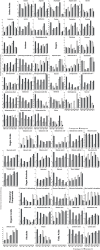Water Deficit Affects Primary Metabolism Differently in Two Lolium multiflorum/Festuca arundinacea Introgression Forms with a Distinct Capacity for Photosynthesis and Membrane Regeneration
- PMID: 27504113
- PMCID: PMC4958636
- DOI: 10.3389/fpls.2016.01063
Water Deficit Affects Primary Metabolism Differently in Two Lolium multiflorum/Festuca arundinacea Introgression Forms with a Distinct Capacity for Photosynthesis and Membrane Regeneration
Abstract
Understanding how plants respond to drought at different levels of cell metabolism is an important aspect of research on the mechanisms involved in stress tolerance. Furthermore, a dissection of drought tolerance into its crucial components by the use of plant introgression forms facilitates to analyze this trait more deeply. The important components of plant drought tolerance are the capacity for photosynthesis under drought conditions, and the ability of cellular membrane regeneration after stress cessation. Two closely related introgression forms of Lolium multiflorum/Festuca arundinacea, differing in the level of photosynthetic capacity during stress, and in the ability to regenerate their cellular membranes after stress cessation, were used as forage grass models in a primary metabolome profiling and in an evaluation of chloroplast 1,6-bisphosphate aldolase accumulation level and activity, during 11 days of water deficit, followed by 10 days of rehydration. It was revealed here that the introgression form, characterized by the ability to regenerate membranes after rehydration, contained higher amounts of proline, melibiose, galactaric acid, myo-inositol and myo-inositol-1-phosphate involved in osmoprotection and stress signaling under drought. Moreover, during the rehydration period, this form also maintained elevated accumulation levels of most the primary metabolites, analyzed here. The other introgression form, characterized by the higher capacity for photosynthesis, revealed a higher accumulation level and activity of chloroplast aldolase under drought conditions, and higher accumulation levels of most photosynthetic products during control and drought periods. The potential impact of the observed metabolic alterations on cellular membrane recovery after stress cessation, and on a photosynthetic capacity under drought conditions in grasses, are discussed.
Keywords: chloroplast aldolase; drought; forage grasses; membrane regeneration; photosynthetic activity; primary metabolites.
Figures






References
-
- Abernethy G. A., McManus M. T. (1998). Biochemical responses to an imposed water deficit in mature leaf tissue of Festuca arundinacea. Environ. Exper. Bot. 40 17–28. 10.1016/S0098-8472(98)00017-3 - DOI
-
- Ap Rees T. (1995). “What next?” in Sucrose Metabolism, Biochemistry, Physiology and Molecular Biology, eds Salerno G. L., Echeverria E. J. (Rockville, MD: American Society of Plant Physiologists; ), 278–283.
-
- Bandurska H. (2001). Does proline accumulated in leaves of water deficit stressed barley plants confine cell membrane injuries? II. Proline accumulation during hardening and its involvement in reducing membrane injuries in leaves subjected to severe osmotic stress. Acta Physiol. Plant. 23 483–490. 10.1007/s11738-001-0059-0 - DOI
LinkOut - more resources
Full Text Sources
Other Literature Sources

